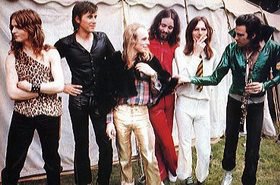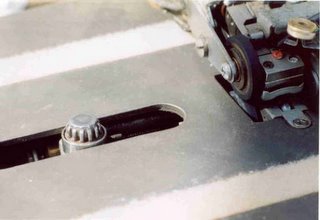In the beginning was television. Television stood not just for the box in the sitting room but for the whole medium; a closed conduit from studio to transmitter, from transmitter to receiver. “What’s on telly tonight” people would say, seeing no separation between broadcast and reception. In the UK till the mid fifties there was only one television channel the BBC. Though ITV started in 1955 and was followed in the early 60’s by BBC2 the overall impression of a single broadcast remained. At times such as Christmas or on national occasions such as a Royal Wedding the TV audiences for a single programme could reach 24 million: over a third of the population. At such moments, nation, television and set are all united in one. When in 1976 the Sex Pistols appeared on the tea time Bill Grundy show and outraged the nation with some rather tame swear words, one irate viewer short circuited the complaints process and kicked in his TV set.

The first artist to tackle Television was Nam June Paik. In Paik’s solo exhibition in 1963, Exposition of Music—Electronic Television, twelve TV sets were scattered around the rooms of the gallery; some on their sides, some upside down, all had been circuit bent to distort their reception of live broadcast transmissions. The exhibition was an extension of the fluxus and Cage inspired work Paik had been doing and it is often forgotten that alongside the TV’s were prepared pianos, off beat sound generators, and an ox’s head. Nonetheless Paik’s sets can be seen as prepared TV’s, or as assisted ready-mades that willfully disrupted the normally seamless broadcast and reception model of viewing.
Paik was gradually to abandon the purely musical elements of his art and concentrate on exploring the TV set as artform. Pieces like
Magnet TV in which a horseshoe magnet twisted the image or
Distorted TV in which the sync pulse is altered led finally to the construction of a series of robots built from vintage TV sets. The focus on the iconography of the set and later, after the advent of the portapak on video as a medium tended to shift Paik’s attention away from the disruption of TV as a broadcast medium. The robot series in particular is more about the TV set as sculptural form than TV transmission; they even had new circuitry to allow modern day video to be replayed.

Arguably then Paik’s most significant intervention in, and on TV was perhaps his first. Towards the end of the 60’s other artist started attempting to disrupt the continuity of viewing. In 1969 the German station WDR 3 television showed
Self Burial consisting of nine photographs of the artist Keith Arnatt slowly entombing himself. The photos were shown one at a time over the course of a week; at first Arnatt is clearly visible but with each new shot he sinks further into the soil. The Photos were broadcast without explanation, one each evening after the news and a second at 9.15. The series continued until the end of the week when an interview with Arnatt revealed all. In a not dissimilar vein David Hall was commissioned in 1971 to make ten TV Interruptions for Scottish Television. These short interventions were broadcast during the time of the Edinburgh Festival. As with Arnatt the pieces were unannounced and uncredited as if some alien signal had broken into and temporarily occupied the channel.

The interventions included piece such as
Burning TV and
Tap. In the latter, possibly the most successful of the works, the screen of the set appears to fill up with water as if it nothing more than an empty glass tank.

Also in 1971 Valie Export made
Facing a Family. This time shown on Austria's ORF station Valie turned the set on its audience by transmitting footage of a family watching the TV at dinner time. The family talks or occasionally moves about but all the time gaze into the middle distance at the unseen set. Valie Export does not so much break the continuity of television but by inserting a mirror creates a potential feedback loop.

Again on Austrian television Peter Weibel’s
T V-News (TV Death 2) 1972 showed a newsreader calmly reading the news, as he does so he takes puffs on a cigarette. Unknown to the audience the hapless reader is in a glass case so as he reads and smokes, the case gradually fills up obscuring him and causing him to cough. The broadcast in this instance chokes itself to daeth.

The newsreader as ultimate symbol of TV authority was further questioned five years later in David Hall’s
This is a Television Receiver. A commission this time for BBC 2,
This is a Television Receiver was the opening sequence for a special Arena programme on Video Art. As with the Scottish intervention the piece is unannounced and features Richard Baker who at the time was perhaps the best-known newsreader on British TV. Baker describes in typically dry tones the functioning of the TV set on which he appears. As the piece proceeds Baker’s image becomes increasingly distorted until it is nothing more than a brown blur filling the screen. Commenting on
This is a Television Receiver in an interview with Chris Meigh Andrews in 2000 Hall says “….For example my mother- forget the art elite- was absolutely distraught when she saw that piece, because she believed in Richard Baker. He was, and had been, the principal news reader. The one person for whom you could suspend all disbelief was the person reading the news. Someone well-loved and seen for so long. Then when his image began to disintegrate and he started to be critical in a sense, of television indirectly, through what he was saying, that whole deconstruction, floored her whole belief. She wasn't involved in the intellectual argument behind it, but it was very disturbing to her that her belief in what was coming out of that box had been fragmented and destroyed”
Hall here may be overstating the impact of the work, the programme was after all on BBC2; a channel renowned for its more eclectic programming not on prime time BBC 1. One wonders if she hadn’t been told about it whether Hall's mother would normally have been watching Arena at all that evening. As with David Hall’s earlier interventions there was something of the science lab aesthetic about the piece. I recall seeing the programme at the time, and aged 16 and with no video art reference points saw Television Receiver as rather akin to something that might have been shown on the science programme Tomorrow’s World rather than an interruption to broadcast dominance.
Still
This is a Television Receiver was the first major artistic intervention on British national TV and despite being on BBC2 was broadcast at a time when the medium’s singularity was still undiluted. In comparison, interventions by the Vasulkas who in 1977 were commissioned to make six half-hour programs for broadcast on WNED in New York lacked the access to mainstream TV that would have given them the same resonance as Television Receiver. Indeed America has always had more channels and given its size a more localised output than European countries and so, a major assault on TV as a unit would always be more problematic, thus for example Chris Burden’s
TV Hijack (1972) and
Promo (1976) were seen by relatively few people.
During the 1980’s artist interventions on UK TV were to become almost commonplace and it began to be apparent that far from subverting the mainstream, artist video programmes were just another slot often, tucked safely away at night when few were watching. Other artists continued the struggle against TV but often from the safety of the gallery. Rather than disrupt the flow of the broadcast medium the approach taken relied more on a re-appropriation of the already broadcast.
Dara Birnbaum’s
Wonder Woman re-edited the transformation sequence from the hit TV series in an effort to subvert and disrupt the narrative flow. In many ways
Wonder Woman was a precursor to scratch TV. In the UK Scratch TV was championed by the Duvet Brothers. Interestingly claims about the impact of their intervention were similar to those made for the earlier Hall interventions. In 1986 Benjamin Woolley in The Listener wrote, “Scratch video establishes a radical new approach to television itself. It abandons the idea that TV images are mere representations of what’s real. It starts to disassemble the images themselves by indulging in orgies of editing. In a sense scratch is the epitome of what professional broadcasters would call irresponsible television.” However TV had long been getting irresponsible and had begun to quote heavily from itself, any danger that Scratch TV might have posed was soon absorbed back into the medium particularly by the Pop Video.
Pop video makers hungry for all and any image manipulation techniques to counterpoint the music quickly nullified Scratch Video’s potential threat. Big TV’s video for Soul 2 Soul’s
Back to Life in 1989 is a classic example opening with a repeated scratch cut that was inspired if not directly by Dara Birnbaum then certainly by the Duvet Brothers. The end result backed as it is by a shuffle beat is not a rupture but a sense of continuity. In such ways scratch lost any power it might have had.

And what of today, in the digital multi channel TV on demand environment, with its knowing audience is there still room and scope for an assault on television? If the title to a recent Steven Ball piece is anything to go by then the struggle continues.
The War on Television is made from images taken from 24 hour rolling news television broadcasts made during the Iraq War. Using the simple technique of connecting and disconnecting the aerial, Steven Ball was able to fragment and stutter the images. A process, which was further, accentuated by employing time line scratch techniques in Final Cut thereby exaggerating the stuttering fragmentation. Describing the piece Ball says “ The pristine digital veneer, the authority and reliability of the always-on 24 hour news channel fucked-up, becoming abstracted into a flow of jarring noise and stammering incoherence. A celebration of digital anti-aesthetics, excess and entropic fallibility.” A description, which of course find many an echo in the works described above. Forty years on from Paik’s intervention it seems the war goes on.
A live version of the
War on Television can be seen tomorrow night (Friday) at the Whitechapel Gallery.















